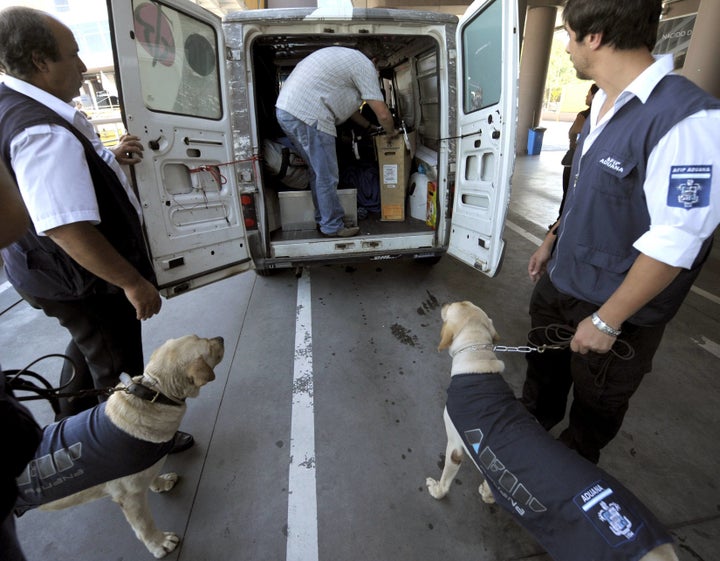
In the course of reporting on the traffic stop of Terrance Huff, HuffPost was able to obtain the reports of an Illinois State Police K-9 unit over an 11-month period in 2007 and 2008. An analysis of those reports shows that only 25.7 percent of the drug dog "alerts" resulted in police finding a measurable quantity of illicit drugs. Just 13 percent resulted in the recovery of more than 10 grams of marijuana, generally considered an amount for personal use, and 10.4 percent turned up enough drugs to charge the motorists or their passengers with at least one felony.
In all, the police dog conducted 252 "sniffs" over the 11-month period, resulting in 136 alerts. The U.S. Supreme Court has ruled that a drug dog's alert is enough to establish probable cause for a warrantless search of a vehicle. Of the 136 alerts, 35 turned up a large enough quantity of drugs to merit an arrest, and 63 turned up what the police officer refers to as "shake," or "residue." The officer didn't send any of those cases to a lab, so it's difficult to know if what the officer found was actually drug residue or, as appears to have been the case in the search of Terrance Huff, likely something else. In 38 cases, or 27.9 percent of the times a dog alert gave cause for a more thorough search, the officer recorded finding no drugs at all. Still, in most of these cases, the officer still notes in the report that the driver or passengers looked to be under the influence of drugs or, somewhat improbably, admitted to him that they were regular drug users. Obviously, there's no way to verify those claims.
One K-9 trainer tells The Huffington Post that police dogs can be trained to only alert when there's a significant quantity of drugs in a car, not merely to residue or the odor of someone who has smoked pot in the recent pass. Most departments don't want dogs trained that way, the trainer says, because they're more interested in dogs that will give them legal cover to conduct a search.
The dog did hit on a few large drug supplies in the report obtained by HuffPost. One alert led to the confiscation of 546 lbs. of marijuana. Other confiscations of 30 lbs., 31 lbs., and 26 lbs., all of marijuana. Of the 136 searches, three found cocaine, one heroin, and one found methamphetamine, all relatively minor amounts. All the other arrests were for marijuana. Oddly, the dog also alerted to a trunk containing 80 cartons of black market cigarettes, even though drug dogs generally aren't trained to alert to the scent of tobacco. Of the 252 total sweeps of motorists over the 11 months, 136 were conducted on out-of-state vehicles.
The drug-dog alerts led to some questionable property seizures under the state's generous (to law enforcement) asset forfeiture law. In one case, the discovery of 2 grams of marijuana led to the seizure of $5,190 in cash. In another, 2 grams of pot led to the arrest of the vehicle's seven occupants and seizure of the $2,000 they had between them. In another, 3 grams of marijuana led to 9 arrests and seizure of $2080. In yet another, one motorist caught with 1.2 grams of pot was arrested and forfeited more than $9,000. Another motorist wasn't arrested, but had more than $2,000 in cash taken from him because the officer found what he says in the report was marijuana residue. It's unclear if the residue was either subjected to a field test or taken to a lab for testing.
The reports describe other searches that some may find surprising. The dog was used to conduct a mass sweep of both a Greyhound bus and a charter bus as they were parked at a rest area. The dog searched 100 lockers at a middle school, and another 350 lockers at a high school. It was also used to sniff 68 doors of an apartment building, as well as 25 vehicles in the building's parking lot. Those sweeps led to one arrest for possession of 8 grams of marijuana.
Even giving this dog credit for the cases in which the officer found only residue, over this 11-month period, the dog had about a 28 percent failure rate. Which means that nearly three of the 10 times the dogs alerted provided probable cause for a warrantless search of a motorist's car without a warrant, the motorist was completely innocent. Include the "residue" stops, which didn't produce a large enough quantity of illicit drugs to be measured, and the dog's error rate climbs to 74 percent. And these are all cases in which the dog's handler presumably was suspicious enough to conduct a sniff search in the first place.
These, of course, are only reports from one K-9 unit from one police agency over roughly a one year span. But they appear to provide another piece of evidence refuting the notion that drug dogs are infallible, or really even reliable enough to establish probable cause.